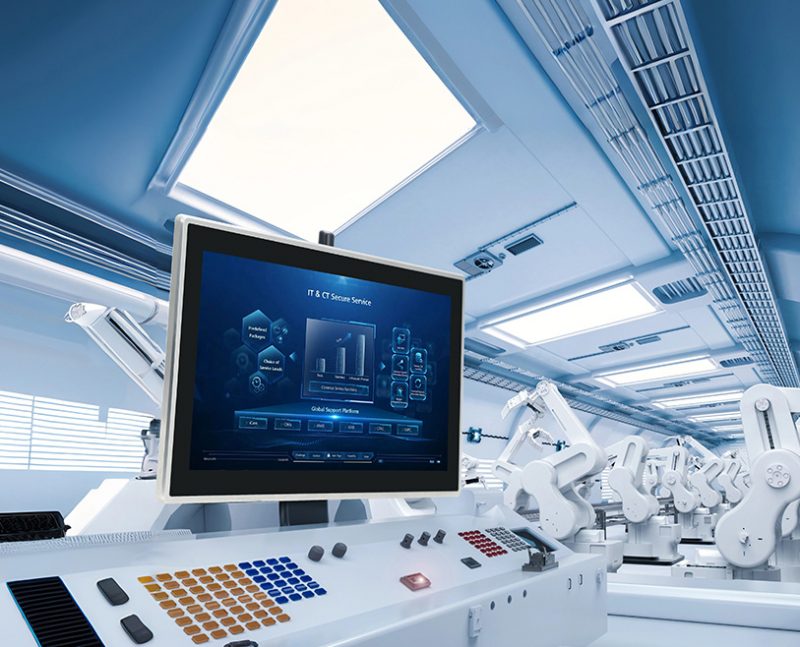In the era of smart manufacturing, robotics automation has become the backbone of efficient, high-precision production—and Industrial Touchscreen Monitors stand as the critical human-machine interface (HMI) powering this revolution. Unlike consumer-grade touchscreens that falter in harsh industrial settings, these specialized monitors deliver robust performance, intuitive control, and reliable connectivity, enabling operators to command, monitor, and troubleshoot robotic systems with unparalleled ease. Whether integrated into collaborative robots (cobots), assembly line automation, or material handling robots, Industrial Touchscreen Monitors bridge the gap between human oversight and robotic efficiency, driving productivity while minimizing downtime. This article explores their core features, key applications, and transformative benefits, helping manufacturing leaders and automation engineers select the ideal touchscreen solution for their robotics systems.

Core Features of Industrial Touchscreen Monitors for Robotics Automation
1. Ruggedized Construction for Industrial Environments
Robotics automation operates in unforgiving settings—exposed to dust, vibration, temperature fluctuations, and mechanical stress—and Industrial Touchscreen Monitors are engineered to endure:
Industrial-grade materials: Tempered glass surfaces with scratch-resistant coatings withstand impacts from tools, debris, or robotic arm collisions.
Environmental resilience: IP65+ ingress protection shields against dust and water splashes, while wide operating temperature ranges (-20°C to 60°C / -4°F to 140°F) adapt to factory floors, cold storage, or high-heat production zones.
Resistência à vibração: Compliant with IEC 60068-2-6 padrões, these monitors maintain performance amid mechanical vibrations from robotic movements or nearby machinery.
2. Real-Time Responsiveness & Precision Control
Robotics automation demands split-second interaction to avoid costly errors—and Industrial Touchscreen Monitors deliver with high-performance touch technology:
Low latency (≤3ms) ensures immediate response to taps, swipes, and gestures, letting operators adjust robotic paths, speed, or task sequences in real time.
Multi-touch support (up to 10 points) enables complex commands—such as zooming into robotic joint coordinates or dragging to reposition waypoints—without cumbersome menu navigation.
Gloved-touch compatibility accommodates operators wearing protective gear, eliminating the need to remove PPE mid-operation.
3. High-Visibility Displays for Clear Data Visualization
Robotic systems generate vast amounts of data—from position coordinates to performance metrics—and Industrial Touchscreen Monitors prioritize readability:
High-resolution (1080p+) screens render detailed robotic schematics, live camera feeds, and sensor data with crisp clarity, supporting accurate decision-making.
High-brightness (500+ nits) panels with anti-glare coatings ensure visibility in bright factory lighting or under direct sunlight, reducing operator eye strain.
Color-coded interfaces (Por exemplo, green for “operational,” red for “fault”) and customizable dashboards let operators quickly identify system status and anomalies.
4. Seamless Integration with Robotics Systems
Compatibility is critical for automation workflows—and Industrial Touchscreen Monitors integrate seamlessly with leading robotics platforms:
Support for industrial protocols: Compatible with PROFINET, Ethernet/IP, Modbus TCP, and CANopen, enabling communication with robotic controllers (Por exemplo, Siemens, Fanuc, ABB, KUKA) and PLCs.
Software compatibility: Works with robotics software suites (Por exemplo, ROS, Fanuc iRVision, ABB RobotStudio) for intuitive programming, simulation, and troubleshooting.
Modular design: Flexible mounting options (panel-mount, arm-mount, ou desktop) adapt to diverse robotic setups, from cobot workcells to large-scale assembly lines.
5. Enhanced Reliability for 24/7 Operations
Manufacturing robotics run around the clock—and Industrial Touchscreen Monitors are built for uninterrupted performance:
Long MTBF (Mean Time Between Failures): Rated for 50,000+ horas de uso contínuo, minimizing downtime for repairs or replacements.
Fanless cooling systems eliminate moving parts, reducing failure risks and ensuring quiet operation in noise-sensitive workspaces.
Backup power options (on select models) prevent data loss during sudden power outages, protecting critical robotic program data.
Key Applications of Industrial Touchscreen Monitors in Robotics Automation
1. Collaborative Robotics (Cobots)
In cobot workcells—where humans and robots work side-by-side—Industrial Touchscreen Monitors enable safe, intuitive interaction:
Teach pendant replacement: Operators program cobot movements directly via the touchscreen, using drag-and-drop interfaces to set waypoints without complex coding.
Safety control: One-touch emergency stop buttons and real-time proximity alerts ensure immediate response if cobots deviate from safe parameters.
Task customization: Quick access to pre-programmed tasks (Por exemplo, pick-and-place, assembly) lets operators switch between workflows in minutes.
2. Assembly Line Robotics
For high-volume production lines (Por exemplo, automotive, eletrônica), these monitors streamline robotic assembly:
Process monitoring: Live dashboards display cycle times, taxas de erro, and part count, letting supervisors optimize throughput.
Remote troubleshooting: Technicians access robotic diagnostics via the touchscreen, identifying issues (Por exemplo, misaligned grippers, sensor malfunctions) without halting the entire line.
Quality control integration: Syncs with vision systems to display real-time part inspection results, enabling robots to reject defective components automatically.
3. Material Handling & Logistics Robotics
In warehouses and distribution centers, Industrial Touchscreen Monitors control automated guided vehicles (AGVs) and robotic arms:
Route planning: Operators set or modify AGV paths via the touchscreen, adapting to dynamic inventory layouts or obstacle avoidance.
Load management: Adjusts robotic gripper force or speed for fragile or heavy items, ensuring safe material transport.
Inventory tracking: Integrates with WMS (Warehouse Management Systems) to display stock levels and update inventory in real time as robots move goods.
4. Precision Robotics (CNC, 3D Printing)
For high-precision applications like CNC machining or robotic 3D printing, these monitors deliver exact control:
Parameter fine-tuning: Touch-based sliders and input fields let operators adjust cutting depths, print speeds, or robotic positioning with micron-level accuracy.
Live feedback: Displays real-time tool wear, material flow, or print layer quality, enabling on-the-fly adjustments to maintain precision.
Benefits of Industrial Touchscreen Monitors for Robotics Automation
1. Boosted Productivity & Throughput
By simplifying control and reducing downtime, Industrial Touchscreen Monitors drive operational efficiency:
Faster setup and changeovers: Intuitive interfaces cut programming time by 30–40% compared to traditional button-based HMIs, letting robots switch between tasks faster.
Minimized human error: Guided workflows and clear data visualization reduce procedural mistakes, such as incorrect waypoint entry or parameter miscalculations.
24/7 operation support: Reliable performance enables uninterrupted robotic runs, increasing production output without adding labor costs.
2. Improved Safety & Risk Mitigation
Safety is paramount in robotics automation—and these monitors enhance workplace safety:
Instant emergency response: One-touch stop controls and visual fault alerts let operators halt robots immediately if hazards arise.
Reduced human-robot interaction: Remote monitoring and programming via the touchscreen minimize the need for operators to stand near moving robotic parts.
Compliance with safety standards: Meets ISO 10218 and ANSI/RIA R15.06 standards for robotic safety, ensuring regulatory compliance.
3. Lower Operational Costs
Industrial Touchscreen Monitors deliver long-term cost savings:
Reduced maintenance: Rugged design and high MTBF lower repair and replacement costs, while fanless cooling reduces energy consumption.
Simplified training: Intuitive interfaces reduce operator training time by 50%, lowering onboarding costs for new staff.
Extended robot lifespan: Precise control and real-time diagnostics prevent premature wear on robotic components, extending their service life.
4. Scalability for Future Growth
As automation needs evolve, Industrial Touchscreen Monitors scale to meet expanding requirements:
Customizable interfaces adapt to new robotic tasks or additional equipment integration.
Software-upgradable firmware adds new features (Por exemplo, AI-powered predictive maintenance alerts) without replacing hardware.
Compatible with emerging robotics technologies (Por exemplo, collaborative mobile robots, autonomous inspection robots), future-proofing your automation investment.
FAQs About Industrial Touchscreen Monitors for Robotics Automation
Q1: Are Industrial Touchscreen Monitors compatible with all robotic brands?
A1: Yes—they support industry-standard protocols (PROFINET, Ethernet/IP, etc.) and integrate with leading brands like Fanuc, ABB, KUKA, Siemens, and Universal Robots. Our team verifies compatibility with your specific robotic system.
Q2: Can these monitors withstand harsh cleaning in food or pharmaceutical facilities?
A2: Absolutely. Food-grade variants feature IP67 protection and are compatible with sanitizing agents (Por exemplo, hydrogen peroxide, alcohol-based cleaners), meeting FDA and EU 10/2011 standards for hygienic environments.
Q3: What is the typical lifespan of an Industrial Touchscreen Monitor in 24/7 robotics operations?
A3: With rugged construction and industrial-grade components, they typically last 7–10 years in continuous use. Most models include a 3–5 year warranty covering defects.
4º trimestre: Do they support remote access for off-site troubleshooting?
A4: Yes—many models offer Ethernet or Wi-Fi connectivity, enabling technicians to access the monitor’s interface remotely for diagnostics, software updates, or program adjustments.
Q5: Can the touchscreen be customized for specific robotic workflows?
A5: Absolutely. We offer custom UI design, including branded interfaces, workflow-specific dashboards, and programmable shortcut buttons tailored to your unique automation needs.
Conclusion
Industrial Touchscreen Monitors are the unsung heroes of robotics automation—delivering the precision, durability, and connectivity needed to unlock the full potential of robotic systems. Whether you’re optimizing assembly lines, streamlining material handling, or integrating cobots into your workflow, these monitors empower operators to work smarter, not harder, while driving productivity, safety, and cost savings. For manufacturing leaders looking to stay ahead in the automation revolution, investing in high-quality Industrial Touchscreen Monitors is a strategic decision that pays dividends in operational excellence.
Ready to enhance your robotics automation with reliable, intuitive touchscreen control? Fill out the form on our website to connect with our automation technology experts. We’ll assess your specific robotic setup, demonstrate integration capabilities, and provide a customized solution proposal—helping you take your automation workflow to the next level of efficiency and precision.

